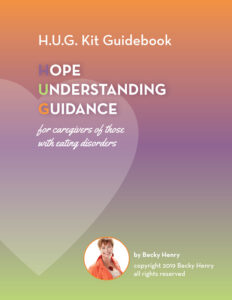 Many family caregivers and/or parents of a child with an eating disorder have shared with me over the past 16 years that there was a point at which they knew their life had to change.
Many family caregivers and/or parents of a child with an eating disorder have shared with me over the past 16 years that there was a point at which they knew their life had to change.
Often there are many small moments that have become eerily common and almost feel ‘normal’ in which family caregivers find themselves responsible for making sure a loved one has their nutritional needs met and are kept safe.
It becomes such a fine line as I mention in this post on Vigilance between hyper-vigilance and an appropriate amount of vigilance.
It may be time to help family caregivers put a plan in place to bring hope into the picture. For caregivers and their loved ones.
Many of you dear clinician colleagues have expressed to me your frustration with parents who are overly anxious and needing a lot of questions answered. It may be helpful to remember that they’re having a normal reaction to an abnormal situation and are in a heightened state of alert in which they’re learning to trust again.
5 Red flags that parents or other family caregivers need support to put a plan into place:
- When counting chia seeds on a child’s oatmeal has become reality.
- When seeing leftovers in a child’s lunch brings on anxiety.
- When a suicidal young person is allowed to attend college/high-school full-time.
- When there is not clarity on the family caregiver’s role with food and support.
- When tears pour out of their eyes at the thought of “backing-off” and they don’t know what that looks like.
Dear clinician, this is when it may be time to help family caregivers put a plan in place to bring hope into the picture. For caregivers and their loved ones.

HUG Kit Guidebook Cover
A plan can include some or all of these tools in my HUG Kits:
- Managing Emotions – Caregivers own and Caregivers Response to Others
- Getting an Oxygen Mask in Place.
- Including Support for the Caregiver
- Education on How to Be an Effective Caregiver
- Communication – With the Team, the Loved-One, Everyone
- RTC – Managing the Journey of Residential Treatment Centers
- Self-Care – Learning it’s Vital and Not Selfish
- Enabling – How to Not Be Up in Their Stuff
- Validating – Calmly, Compassionately and Confidently
- Boundaries – Keeping Everyone Safe
Observing the distress levels go way down and the capacity of family caregivers go way up is not only exciting, it makes it so much easier for the treatment professionals who are working with the families to be even more effective.
- Caregivers have the right to support which a loved one has a chronic health or mental health condition.
- What is most detrimental to the mental health of a parent or caregiver is to witness a loved one’s suffering, and feel helpless or ineffective in the face of it (Monin, 2016).
Practicing these tools is a form of self-care for family caregivers. Providing tools for families at treatment centers to get their own oxygen masks firmly in place is life giving and a game changer for all. Together we can change treatment outcomes and give families back their loved ones.

